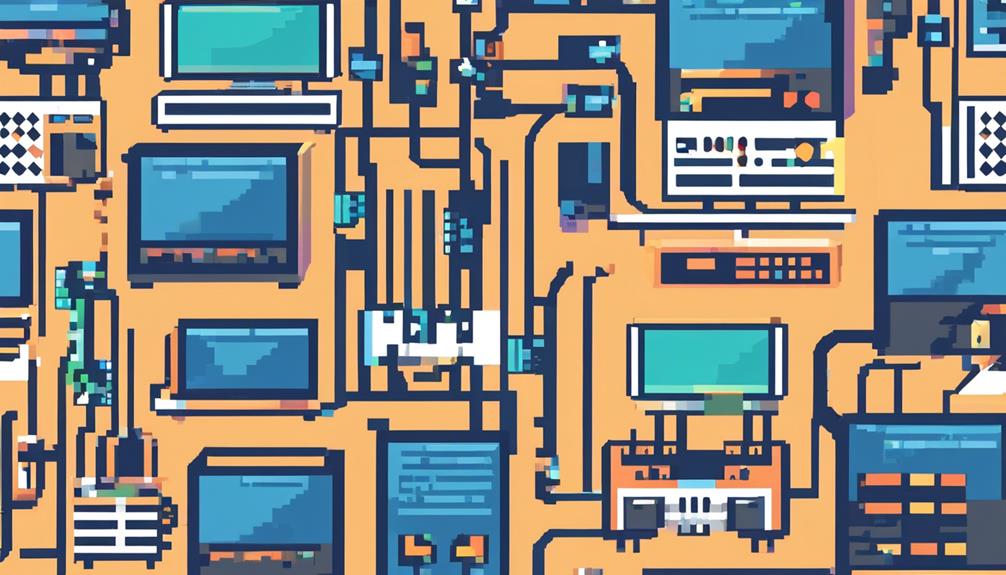In today's digital age, remote work has become increasingly prevalent, requiring organizations and individuals to rely heavily on network hardware to establish a seamless and secure work environment.
The right network hardware can make all the difference in ensuring productivity and efficiency while working remotely. From laptops versus desktops to ergonomic furniture and internet routers, each component plays a crucial role in creating a conducive remote work environment.
However, the challenges of network security and the intricacies of setting up a home office also demand careful consideration.
In this discussion, we will explore the various aspects of network hardware for remote work, providing valuable insights and best practices to help you optimize your remote work experience.
Key Takeaways
- Traditional routers may not provide adequate Wi-Fi coverage, so it is important to consider using mesh networks for extended coverage and consistent connectivity.
- Strong internet routers or mesh networks significantly improve productivity and efficiency in remote work setups.
- Reliable and seamless Wi-Fi connection is crucial for uninterrupted productivity and secure remote work.
- Implementing wired network solutions, enabling Wi-Fi 6 and WPA3 security protocol, and setting up VLANs or guest networks can enhance network security for remote work.
Laptop Vs. Desktop for Remote Work

When considering the hardware options for remote work, the choice between a laptop and a desktop depends on the specific needs and preferences of the employees.
Laptops offer flexibility and mobility, making them ideal for remote work that involves travel. With a laptop, employees can easily carry their workstations with them, allowing them to work from any location. This portability is especially useful for employees who frequently travel or need to work from various client sites.
On the other hand, desktops provide robust computational power and long-term sustainability for remote work setups. They are typically more powerful than laptops, allowing employees to handle resource-intensive tasks with ease. Additionally, desktops are generally more durable and easier to upgrade or repair, making them a reliable choice for long-term remote work arrangements.
While laptops offer mobility, their smaller screens may limit productivity for some employees. However, this can be overcome by using wide-screen monitors in conjunction with laptops, enhancing the display and multitasking capabilities. It is crucial to consider employees' software preferences and display size when choosing the best laptop for remote work. Some employees may require specific software that is only compatible with certain operating systems, while others may prefer larger displays for enhanced productivity.
One notable laptop option for remote work is the M1 Macbook Air series from Apple. These laptops offer sustainable efficiency, impeccable performance, and affordability. With their powerful M1 chip, employees can handle demanding workloads while enjoying extended battery life. The M1 Macbook Air series is an excellent choice for remote work, combining performance, portability, and value.
Ergonomic Desks and Chairs
Ergonomic desks and chairs are essential components of a remote work setup, prioritizing comfort and productivity for employees. When working from home, it is important for remote workers to have the proper home office equipment to support their well-being and ensure optimal performance. Here are a few key reasons why ergonomic desks and chairs are crucial for employees working from home:
- Enhanced comfort: Ergonomic chairs are designed with features such as lumbar support to promote spine health during long work hours. This helps prevent the development of back pain and discomfort, allowing employees to focus on their tasks without distractions.
- Improved posture: Adjustable desks enable employees to find the ideal height for their workstations, preventing strain on the back and neck. By promoting better posture, ergonomic furniture reduces the risk of musculoskeletal issues and enhances overall well-being.
- Health benefits: Poor quality desks and chairs can lead to health-related problems, such as poor circulation and increased fatigue. Ergonomic furniture, on the other hand, creates a better work environment by prioritizing employee well-being, resulting in increased comfort and productivity.
- Long-term investment: Investing in ergonomic desks and chairs demonstrates a commitment to the health and well-being of remote workers. By providing employees with the necessary equipment, employers can foster a positive work environment and potentially reduce the likelihood of work-related injuries.
Strong Internet Routers or Mesh Network

Investing in strong internet routers or mesh networks is crucial for ensuring reliable and seamless Wi-Fi coverage in remote work environments. As more people work remotely, the demand for a stable and fast network connection has increased significantly. Traditional routers may not provide adequate coverage, especially in larger spaces or areas with multiple devices. This is where strong internet routers or mesh networks come into play.
A mesh network is a network topology that uses multiple access points to extend Wi-Fi coverage. It eliminates dead zones and ensures consistent connectivity throughout the remote work environment. With a mesh network, the Wi-Fi signal is distributed evenly, allowing for a stronger and more reliable connection.
To further highlight the benefits of investing in strong internet routers or mesh networks, the following table provides a comparison between traditional routers and mesh networks:
| Traditional Routers | Mesh Networks | |
|---|---|---|
| Wi-Fi coverage | Limited coverage | Extended coverage |
| Connectivity | Inconsistent | Consistent |
| Scalability | Limited | Highly scalable |
| Device support | Limited | Supports multiple devices |
| Security features | Basic | Enhanced security |
In addition to providing extended coverage and consistent connectivity, strong internet routers and mesh networks also offer enhanced security features. They can be easily managed and monitored to ensure optimal performance. Investing in these network hardware solutions can significantly improve the overall productivity and efficiency of remote work setups by providing a reliable and seamless Wi-Fi connection for all devices.
Work-From-Home Cybersecurity Best Practices
To ensure uninterrupted productivity and secure remote work, implementing strong internet connectivity and reliable cybersecurity tools is essential, especially when it comes to following work-from-home cybersecurity best practices. Here are some key practices to consider:
- Implement wired network solutions: Wired networks provide better security and network performance compared to wireless networks. Consider using products like TP-Link Litewave 8 Port Gigabit Ethernet Switch or Netgear Wireless Access Point (WAX610) Wi-Fi 6 Dual-Band for a more stable and secure connection.
- Enable Wi-Fi 6 and WPA3 security protocol: Wi-Fi 6 offers faster and more reliable wireless connectivity, while WPA3 provides enhanced security features. Products like Eero 6 dual-band mesh Wi-Fi 6 system or Linksys MX10600 Velop Wi-Fi 6 Mesh Router offer these advanced features for a more secure remote work environment.
- Implement network segmentation and access control: By using techniques such as Access Control Lists (ACLs), MAC addresses, and multiple SSIDs, you can prevent unauthorized access and enhance network security. This helps to isolate devices and control who can access specific parts of your network.
- Set up VLANs or guest networks: VLANs allow you to separate devices into different virtual networks, providing an added layer of security. Guest networks are useful for isolating guest devices from your main network. Additionally, configuring Quality of Service (QoS) can prioritize critical tasks and ensure a smooth remote work experience.
Work-From-Home Cybersecurity Tools

When it comes to work-from-home cybersecurity, there are several essential tools that can help ensure the security of remote connections.
Secure VPN connections provide encrypted access to company resources, while firewall protection helps defend against unauthorized access.
Multi-factor authentication adds an extra layer of security by requiring multiple forms of verification for remote access.
Secure VPN Connections
Secure VPN connections are essential for ensuring the confidentiality and security of remote work. Here are some key points to consider regarding secure VPN connections for remote work:
- VPNs encrypt data, providing a secure tunnel for remote workers to access company networks and resources.
- Implementing multi-factor authentication adds an extra layer of security when using VPN connections.
VPNs help prevent unauthorized access and protect against potential cyber threats.
- It is important to choose VPN solutions that offer robust security features and regular updates for optimal protection.
Firewall Protection
With secure VPN connections established, the next crucial step in ensuring remote work cybersecurity is implementing firewall protection as a barrier against external threats. Firewall protection acts as a safeguard between the internal network and potential attackers. It monitors and controls incoming and outgoing network traffic based on predetermined security rules, preventing unauthorized access.
Firewalls can be hardware-based or software-based and play a critical role in protecting sensitive company data and systems. By providing a secure gateway for remote workers, firewalls ensure that only authorized traffic is allowed to pass through the network.
Implementing firewall protection is essential for maintaining the security and integrity of a remote work network, especially in the context of the increased vulnerability of remote equipment and the need to protect against cyber threats.
Multi-Factor Authentication
Multi-Factor Authentication (MFA) is a crucial cybersecurity tool for remote work environments, providing an additional layer of protection against potential cyber threats.
Here are some key facts about MFA:
- MFA requires multiple forms of verification, such as a password, fingerprint, or security token, before granting access to systems or data.
- It helps prevent unauthorized access and strengthens cybersecurity by making it harder for attackers to breach accounts or networks.
- Common MFA methods include SMS codes, biometric recognition, security questions, smart cards, and push notifications to authenticate user identities.
- By implementing MFA, remote workers can enhance the security of their devices and networks, reducing the risk of data breaches and unauthorized access.
Incorporating MFA into network hardware for remote work is essential to ensure a robust security infrastructure.
Remote Work Expenses and Stipend Guide

The Remote Work Expenses and Stipend Guide provides invaluable insight and guidance on managing and understanding the expenses associated with setting up a remote work environment. For organizations transitioning to remote work, it is crucial to consider the expenses related to network hardware and other essential equipment.
When it comes to network hardware, remote workers require reliable and secure connections to access company resources. Expenses related to network hardware may include routers, modems, switches, and VPN solutions. These components ensure a stable and secure network connection, allowing employees to collaborate effectively and access corporate systems securely.
In addition to network hardware, remote work expenses can encompass a wide range of items. The guide offers information on stipends and allowances that can be provided to employees to cover these expenses. It outlines the different categories of expenses that may be incurred by remote workers, such as internet services, mobile data plans, home office equipment, and utilities.
Creating a fair and transparent stipend policy is essential to ensure that remote employees are adequately supported. The guide provides insights on structuring stipends in a way that covers various expenses while considering the needs of different employees. It also addresses tax implications and compliance considerations related to remote work stipends, ensuring organizations remain in line with regulatory requirements.
Setting up a Home Office for Remote Work
What are the essential components for setting up an efficient home office for remote work?
When setting up a home office for remote work, there are several essential components to consider. These components will not only enhance productivity but also create a comfortable and functional workspace. Here are some key elements to include in your home office setup:
- Laptop or Desktop: Choose the right device based on your needs and preferences. Laptops offer flexibility, especially for remote employees who travel frequently, while desktops provide more computational power and long-term sustainability.
- Proper Desktop Setup: If you opt for a desktop computer, ensure you have a suitable desk and chair. Ergonomic work environments, including comfortable desks and chairs with lumbar support, are essential for enhancing productivity and preventing health-related problems.
- Strong Internet Connection: Remote workers rely heavily on a stable and fast internet connection. Invest in a strong primary router and consider using ethernet solutions for a more reliable connection. Additionally, implement reliable cybersecurity tools and best practices to ensure the safety of your network.
- Display and Accessories: Choose a display that suits your needs and provides a comfortable viewing experience. Consider factors such as display size and resolution. Additionally, invest in accessories like a keyboard, mouse, and webcam to enhance your productivity and communication during remote work.
Essential Remote Work Equipment

When it comes to remote work, having the right equipment is crucial for productivity and efficiency. In order to effectively work remotely, employees require the appropriate hardware to support their tasks.
Laptops are a popular choice for remote work due to their portability and flexibility. They allow employees to work from various locations and are particularly beneficial for those who travel frequently.
On the other hand, desktops offer more computational power and long-term sustainability for remote work setups. They are ideal for employees who require high-performance computing capabilities.
To enhance the display for multitasking, wide-screen monitors can be used in conjunction with laptops. When choosing the best laptop for remote work, it is important to consider employees' preferences for operating software and display size.
Additionally, creating an ergonomic work environment is crucial for remote employees. Comfortable desks, chairs, and adjustable desks can enhance productivity and promote good health.
It is essential to prioritize the well-being of remote employees by providing them with the necessary equipment to create an efficient and comfortable workspace. This includes not only the network hardware required for connectivity but also the physical equipment needed for remote work.
Best Practices for Providing Equipment
When providing equipment for remote work, it is important to consider equipment selection tips, remote work setup, and hardware deployment strategies.
By carefully selecting the right equipment that suits employees' work requirements and environment, such as laptops or desktops, ergonomic peripherals, and dual monitors, you can enhance their productivity and efficiency.
Additionally, implementing a proper remote work setup, including ergonomic furniture and strong internet connectivity, along with deploying hardware effectively, can contribute to a comfortable and secure remote work environment.
Equipment Selection Tips
To ensure optimal productivity and satisfaction among remote employees, it is essential to carefully consider the selection of equipment for their work setups. When it comes to network hardware for remote work, here are some equipment selection tips to keep in mind:
- Portability and flexibility: Consider laptops that are easy to carry and suitable for employees who travel frequently.
- Computational power and sustainability: Desktops provide the necessary computational power and long-term sustainability for employees working from a fixed location.
- Larger display options: Pairing wide-screen monitors with laptops can enhance productivity for remote work.
- Employee preferences: Take into account operating software and display size preferences when selecting the best laptop for remote work.
Remote Work Setup
For optimal remote work setups, it is essential to follow best practices when providing equipment. When it comes to network hardware, laptops and desktops are the primary options to consider.
Laptops offer flexibility and mobility, making them ideal for remote employees who travel frequently. On the other hand, desktops provide greater computational power and long-term sustainability for remote work setups.
Pairing laptops with wide-screen monitors can enhance the remote work experience by providing a larger and more immersive display.
When selecting the best laptop for remote work, it is crucial to consider employees' preferences for operating software and display size. The M1 Macbook Air series from Apple offers impeccable performance, sustainable efficiency for over five years, and an affordable price point, making it an ideal choice for remote work setups.
Hardware Deployment Strategies
With regards to hardware deployment strategies for remote work setups, it is crucial to consider the optimal equipment to provide for remote employees. To ensure productivity and efficiency, here are some best practices for providing hardware:
- Provide laptops: Laptops offer flexibility and mobility, allowing employees to work from anywhere. They are essential for remote work as they provide the necessary tools and software for day-to-day tasks.
- Evaluate desktops: Desktops offer higher computational power and long-term sustainability. Consider providing them for employees who require more processing capabilities or have specialized tasks.
- Utilize wide-screen monitors: Enhance the display for remote workers using laptops by providing wide-screen monitors. This improves visibility and productivity, especially when working with multiple applications simultaneously.
- Ensure ergonomic furniture: Remote employees should have access to ergonomic furniture to promote a comfortable work environment and minimize the risk of musculoskeletal issues.
Ensuring Network Security for Remote Workforces
Implementing strong network security measures is crucial for remote workforces to ensure reliable cybersecurity and protect sensitive data. When it comes to remote work, the network is the lifeline that connects employees to their work environment. To enhance network security, organizations can deploy various hardware solutions and follow best practices.
Firstly, organizations should consider using primary routers or ethernet solutions that can improve connection speeds for remote workers. This ensures that employees can work efficiently and securely without experiencing network disruptions. Additionally, organizations should educate remote workers on best practices for work-from-home security. This includes using strong passwords, regularly updating software and applications, and being cautious of phishing attempts.
Using wired Ethernet connections can enhance network security and performance. By connecting PCs, printers, and work equipment to a small switch on the desk, organizations can establish a more secure network environment. Wired connections are less susceptible to interference and eavesdropping compared to wireless networks.
Upgrading to Wi-Fi 6 and WPA3, the latest wireless technologies, can provide faster and more secure wireless connections. It is important to ensure that devices used by remote workers support these technologies for compatibility and better network security.
Furthermore, organizations can set up VLANs (Virtual Local Area Networks) or guest networks to separate devices and provide dedicated network lanes for specific devices. This segmentation helps in isolating network traffic and prevents unauthorized access to sensitive data. Prioritizing network traffic based on device and application needs ensures optimal performance and security.
Frequently Asked Questions
How Do I Network When I Work Remotely?
When working remotely, networking plays a crucial role in ensuring smooth operations. To optimize remote connections, troubleshoot network issues promptly and ensure a stable internet connection.
Utilize remote collaboration tools to facilitate communication and collaboration with teammates.
Additionally, prioritize remote work productivity by setting up a dedicated workspace, establishing a routine, and minimizing distractions.
Implementing these network troubleshooting techniques and following remote work productivity tips will help maximize efficiency and effectiveness while working remotely.
How Can I Secure My Home Network for Work From Home?
To secure your home network for remote work, there are several essential measures to consider.
First, enable home network encryption to protect data transmission.
Implement two-factor authentication for remote work to add an extra layer of security.
Utilize a VPN for secure remote access, ensuring that all data transmitted is encrypted and protected.
Lastly, deploy a firewall to safeguard your home network from unauthorized access and potential cyber threats.
These measures will help create a secure environment for your remote work activities.
What Technology Is Needed for Remote Working?
To support remote work, essential technologies include remote work tools, reliable internet connectivity, collaboration software, and cybersecurity measures.
Remote work tools enable employees to access files, communicate, and collaborate from anywhere.
Strong internet connectivity ensures uninterrupted productivity.
Collaboration software facilitates seamless communication and teamwork.
Cybersecurity measures, such as firewalls, VPNs, and encryption, protect sensitive data and prevent unauthorized access.
These technologies collectively create a secure and efficient remote work environment.
What Computer Do You Need for Remote Work?
The computer specs required for a remote work setup depend on the nature of the work and the specific tasks involved. Generally, a reliable laptop or desktop with sufficient processing power, memory, and storage is necessary.
Internet requirements include a stable high-speed connection to ensure smooth virtual collaboration using tools like video conferencing and file sharing.
It is essential to prioritize cybersecurity measures to protect sensitive data and maintain productivity.
